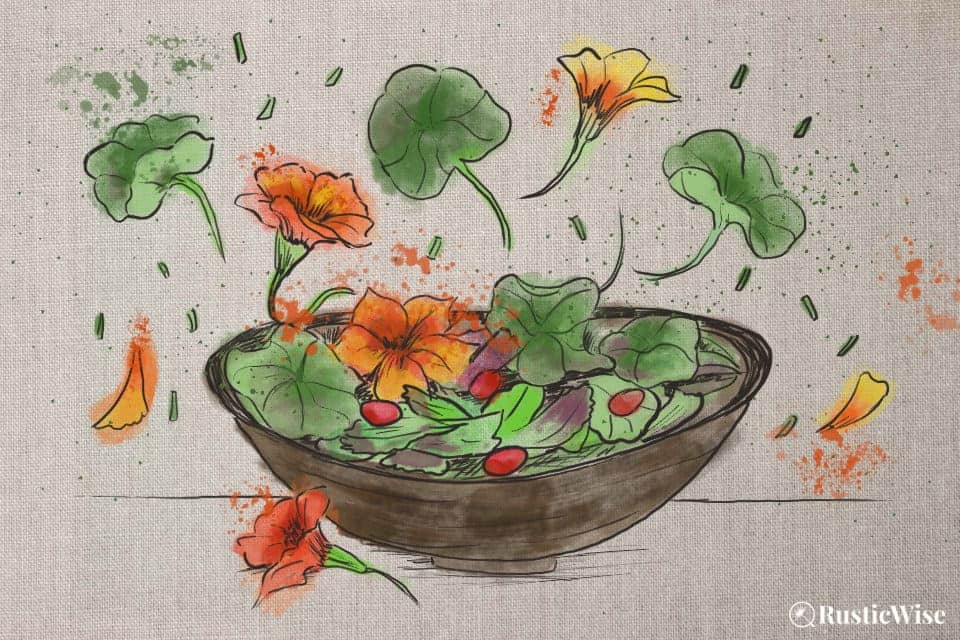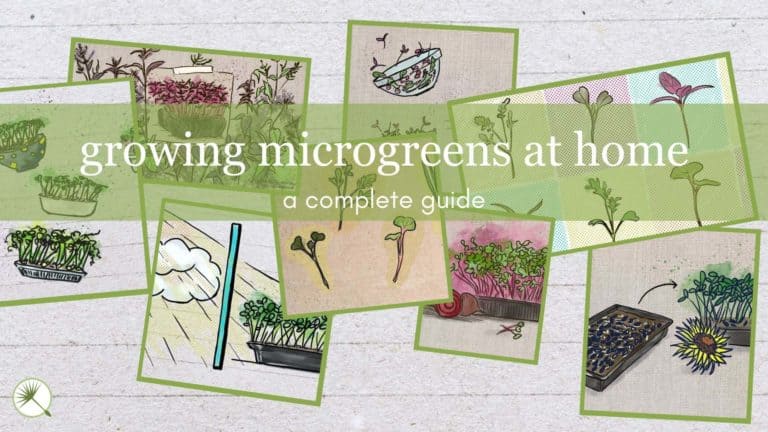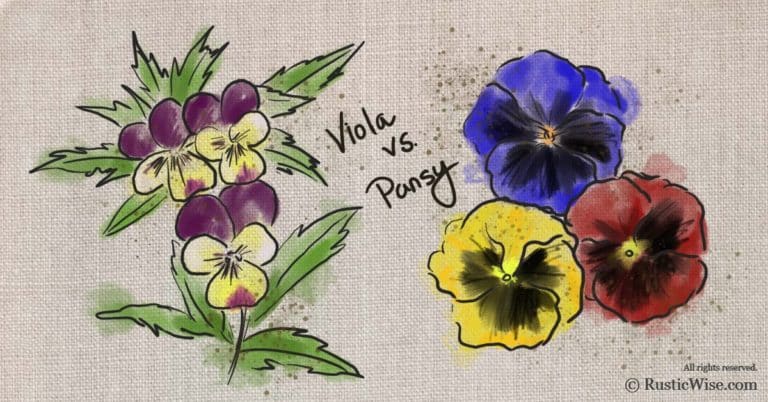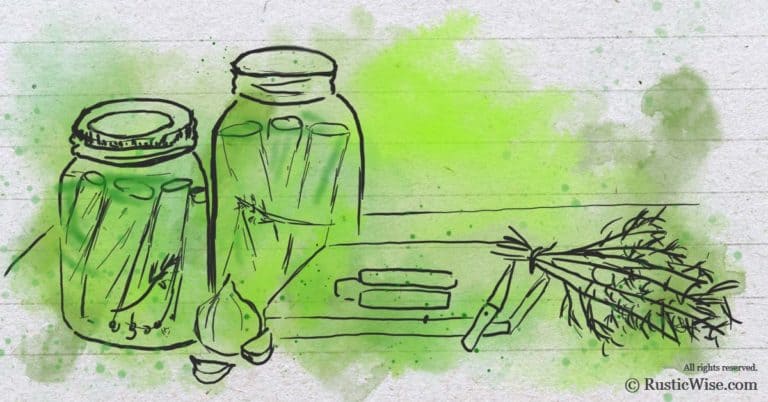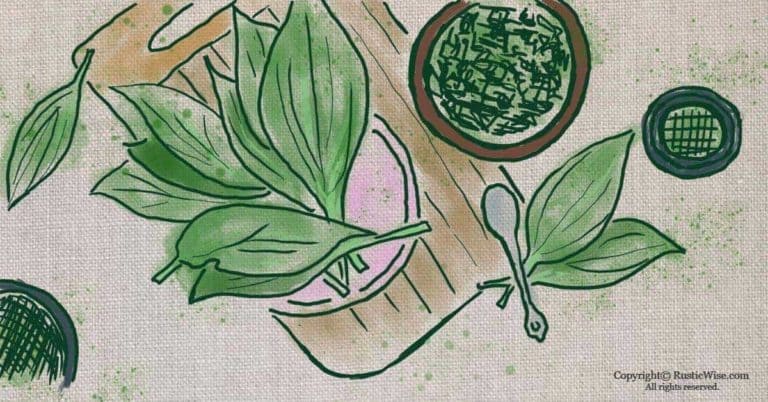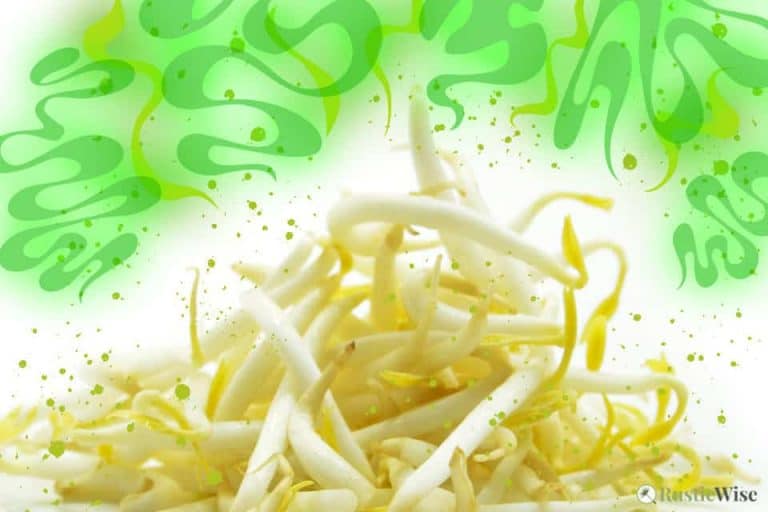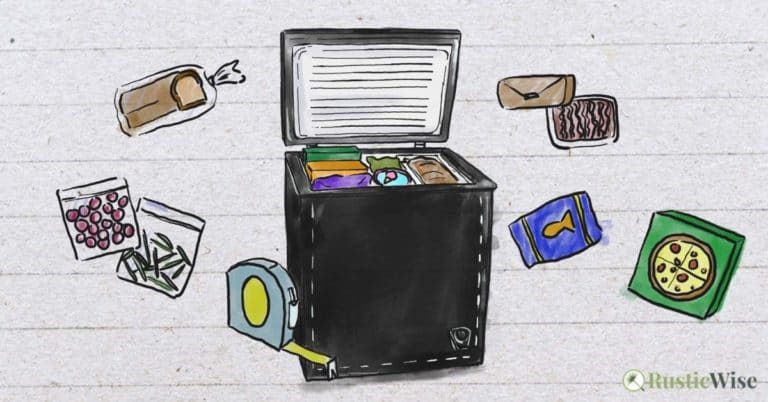Can You Eat Nasturtiums? How To Eat the Seeds, Stems, Leaves & Flowers
RusticWise is supported by its readers. When you purchase through links on our site, we may earn an affiliate commission. As an Amazon Associate, we earn from qualifying purchases. Thank You!
With vibrant flowers and leaves that resemble lily pads, nasturtiums are a sight to behold. It turns out that not only is this flowering plant beautiful, it’s also one you’ll want to incorporate into your culinary creations.
So, can you eat nasturtiums? Yes, the whole plant is edible. From the flower buds to the leaves, stems, and even the seeds, there are plenty of ways to use this versatile plant. The leaves and blooms have a peppery flavor, while the seeds are often pickled to make nasturtium capers.
Along with dandelions and Johnny Jump Ups, you’ll want to add nasturtium plants to your list of edible flowers and wild edible food. Don’t forget to check out my two easy-peasy recipes using flowers, leaves and stems: nasturtium toast and crackers. Plus, there’s a pickling recipe for the seeds.
A closer look at nasturtium plants
This flowering plant belongs to the family Tropaeolaceae. The most common species is Tropaeolum majus, sometimes known as Indian cress. This edible climbing plant has round, dark green leaves that look like lily pads, and flowers that range in color from cream, bright yellow, orange, and red.
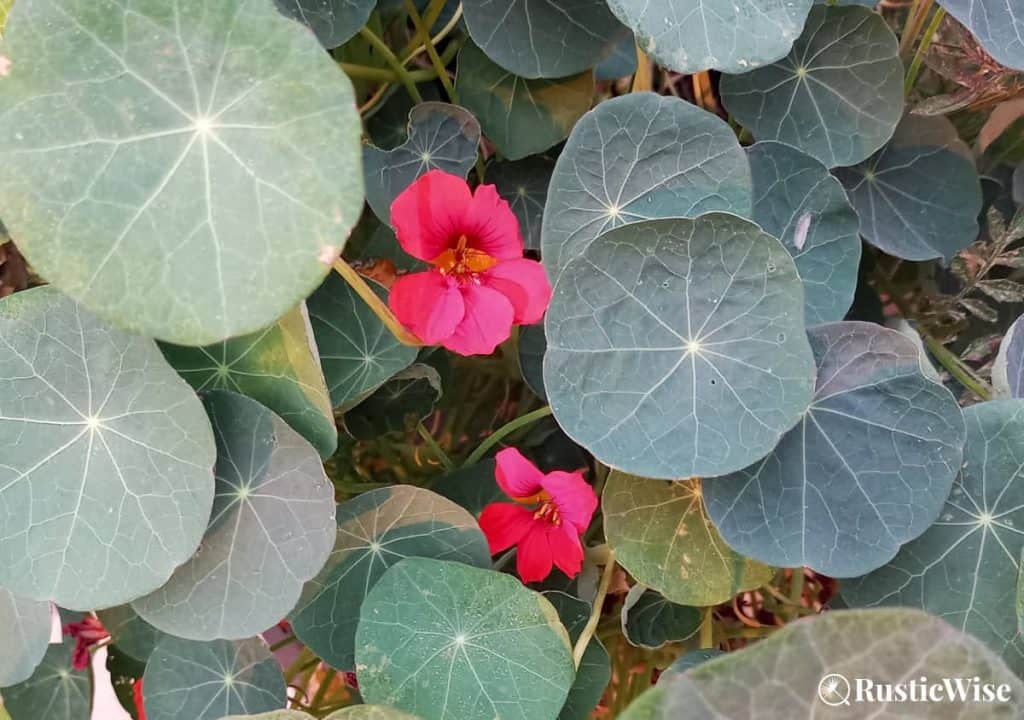
Credit: RusticWise
Tropaeolum majus is most often planted as an annual, but can be kept as a perennial in USDA zones 8 to 11.¹
Native to South America, in particular Peru, you can find nasturtium naturalized in many parts of Europe.
Note: Don’t confuse this plant with the genus Nasturtium which includes aquatic herbs and plants, such as watercress, which belong to the Brassicaceae family. (Ironically, many say that nasturtium petals, leaves, and stems share the same peppery taste and spicy flavor as watercress.)
Common nasturtium varieties
There are many members of the Tropaeolum family. Here are a few common varieties:²
- Dwarf nasturtium (Tropaeolum minus): A popular non-climbing variety, this plant features small, but beautiful blooms measuring roughly 1.2 inches (3 centimeters) across. Works great as a border plant!
- Canary creeper (T. peregrinum): Brighten up your garden with this cheerful climber with frilly light yellow blooms.
- Shield nasturtium (T. peltophorum): If you prefer orange-red blooms, you might like this climber with tiny flowers 1 inch (2.5 centimeters) long.
Can you eat nasturtiums? Yes, here’s how
If you love this plant’s peppery flavor, there are endless ways to use it to enhance and elevate everyday dishes.
Nasturtium flowers
Besides looking pretty, nasturtium blooms are also completely edible. They’re one of my favorite edible flowers! Tasty, easy to grow, and low maintenance—what more could a home gardener ask for?
The edible blossom has a more delicate peppery flavor than the leaves and the seeds.
Tip: The flowers are best fresh. Pick right before using, as they wilt quickly.
Here are some ways to incorporate flowers to brighten up your plate:
- Use as a beautiful garnish on savory dishes and desserts.
- Add the flower whole (or break apart the petals) to add a splash of color and a bit of spice to salads.
- Make a blossom sandwich (see recipe below!).
- Add to beverages or spicy cocktails. Wouldn’t a nasturtium bud go great with a Ceasar, or a spicy margarita?
- Make your own spicy blossom-infused vinaigrette dressing.
- Eat them raw, fresh from the garden.
Edible leaves
Nasturtium leaves are completely edible. Flavorful with peppery notes, they’re best enjoyed raw, as the delicate leaves don’t hold up well if steamed or sautéed.
If you’re a fan of peppery notes, you’ll love nasturtium leaves as they taste like a cross between watercress and radish.
One thing you’ll quickly learn about nasturtium leaves is that they grow big fast. If you want to harvest the young, tender leaves, you’ll need to pick them sooner rather than later.
Small leaves tend to have a milder flavor. They also have a tender texture.
Larger leaves are packed with a peppery punch, some bordering on the bitter.
Here’s how to use nasturtium leaves to spice up your culinary dishes:
- Use as part of leafy mix to add to green salads.
- Use as you would a spicy salad green. Add to sandwiches (see recipe below) and wraps.
- Chop up a few leaves and add to omelettes.
- Sprinkle leaves on top of pizza (raw or lightly cooked).
- Add to your favorite pesto recipe for a bolder flavor. The spicy notes complement the pine nuts and basil in most pestos.
- Add to soups, stews, or sauces during the last few minutes of cooking.
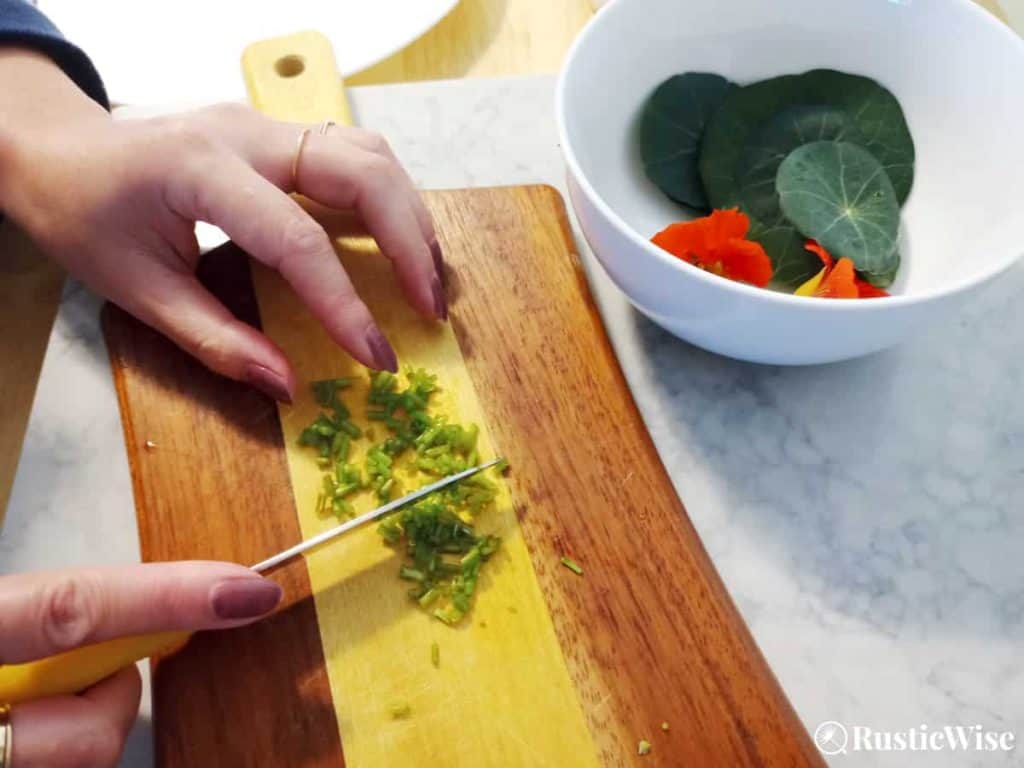
Credit: RusticWise
Spicy stems
You can use this edible flowering plant as a chive substitute. It has a nice crispy texture and a zingy flavor.
Here’s how to eat the stems:
- Dice up and use as a garnish on savory foods. Think baked potatoes, salads, pizza, or anytime you want a dash of spice.
- Sprinkle on top of hors d’oeuvres.
- Add to quiches or omelettes.
Seeds and seed pods
Nasturtium seed pods have the most potent flavor of all the plant parts. They taste like spicy watercress or radish.
The light-green seed pods are commonly used like capers—pickled.
- Make nasturtium capers! There are myriad recipes for pickling the seeds of this plant (see below).
- Use as a caper substitute. If your recipe calls for capers and you don’t have any, these spicy pickled seeds will make a suitable alternative.
- Use as a pepper substitute. Pick and dry seed pods. Grind into a fine powder and sprinkle as you would black pepper.
- Add to pickles or chutneys for a spicy kick.

Credit: RusticWise
How to harvest nasturtiums
Nasturtiums are easy to grow and require little maintenance once established. They’re also delicious!
The best time of day to harvest nasturtiums is in the early morning.
- Flowers: Flowers are ripe for picking all summer long. Most plants bloom in July and may continue to have blossoms until September. Pluck the edible blossoms as you see fit during the growing season. The entire flower is edible.
- Leaves and stems: To harvest young leaves and stems, begin picking in early summer. You can enjoy a steady supply of fresh greens until the first autumn frosts. Younger leaves are great in salads; older leaves may still be good, just do a taste test first!
- Seed pods: Pick seed pods while still green. The best time to pick nasturtium seeds is just after the flowers have died and just before the seeds turn yellow and dry. This is often sometime between August and October.¹
Preparing and storing nasturtium for use in the kitchen
Using leaves and flowers is as simple as giving them a quick rinse.
Under a gentle stream of cool water, rinse the leaves and flower heads clean.
Let them air dry or gently pat dry with a clean towel. You can store them in the refrigerator for up to two or three days in a container or baggie.
Are nasturtiums healthy to eat?
Yes, nasturtiums have a wide range of health benefits. The leaves are an excellent source of vitamins A and C, as well as fiber and folate.³
Nasturtium flowers also contain vitamin C. Just 100 grams of flowers contain roughly 130 milligrams of vitamin C.¹
The seeds are composed of roughly 26 percent protein.¹
Notes of caution when eating nasturtiums
It’s important to note that nasturtium seeds contain high levels of oxalic acids. Foods high in oxalic acids may lock in other minerals such as calcium. This may increase your chance of developing kidney stones.³
Eat seeds in moderation.
Those with kidney disease or gastrointestinal ulcers may want to avoid eating.
Nasturtium recipes
Can you eat nasturtiums? Absolutely! If you like easy, no-fuss recipes, I’ve got two tasty recipes using nasturtium leaves, stems, and blossoms.
Both these recipes require freshly harvested leaves and flowers.
Note: Rinse fresh leaves and flowers. Finely chop the stems as a garnish.

Credit: RusticWise
Nasturtium blossom and leaf toast
This is a quick and easy recipe that’s perfect for snacks, breakfast, or as part of a lunch.
Remember that nasturtium leaves are on the spicy side and a little goes a long way. Add more (or fewer) leaves to taste.
This recipe is an open-faced sandwich or toast (kind of in the spirit of avocado toast).
You’ll need:
- 2 slices of toasted bread
- Mayonnaise (cream cheese or butter would also work)
- Thinly sliced cucumber
- Diced nasturtium stems
- A handful of clean nasturtium leaves and flowers
- Coarse sea salt (I like pink Himalayan sea salt)
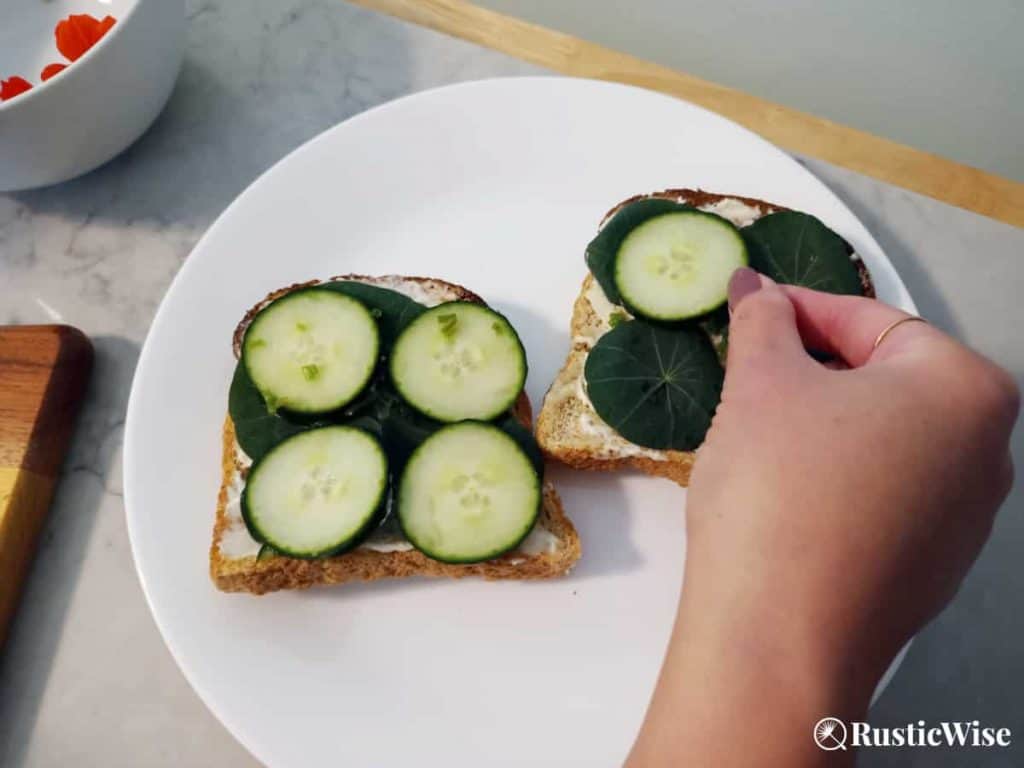
Credit: RusticWise
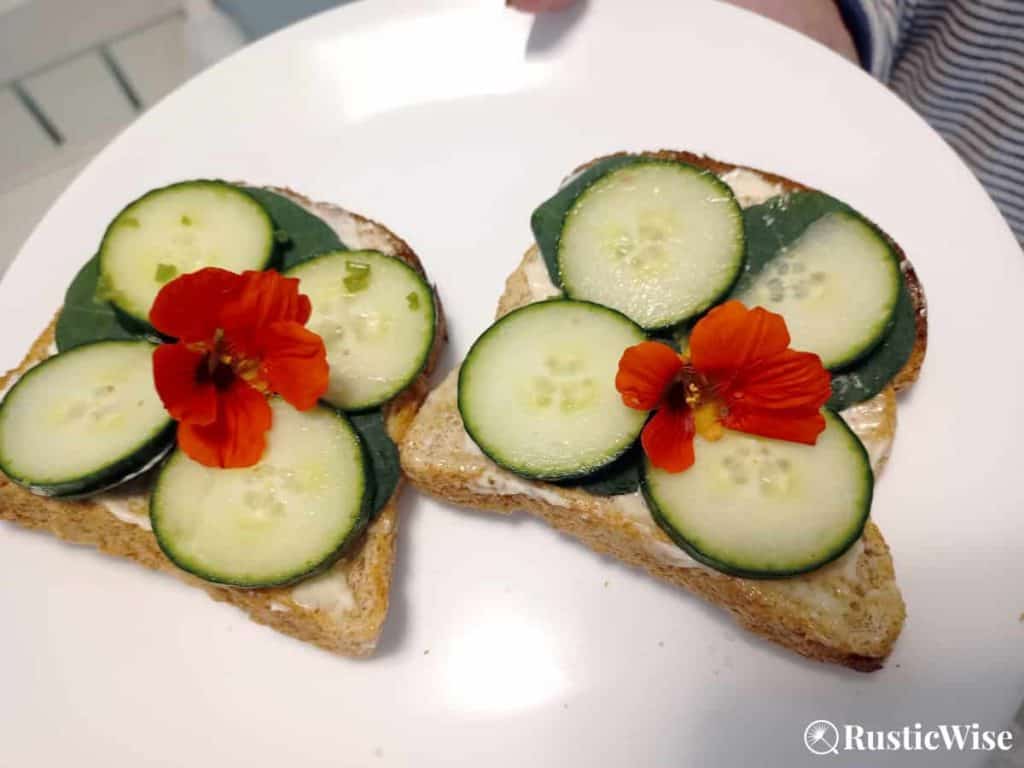
Credit: RusticWise
- Spread mayo onto toasted bread.
- Sprinkle diced stems onto the mayo.
- Layer whole nasturtium leaves on the toast.
- Spread thinly sliced cucumber on top.
- Garnish with coarse sea salt.
- Top off with a nasturtium flower or two.
Enjoy!
Nasturtium blossom crackers
This would make a perfect after school/work/post-workout snack. Remember that the flowers wilt quickly (so sadly this recipe wouldn’t hold up well for a party snack).
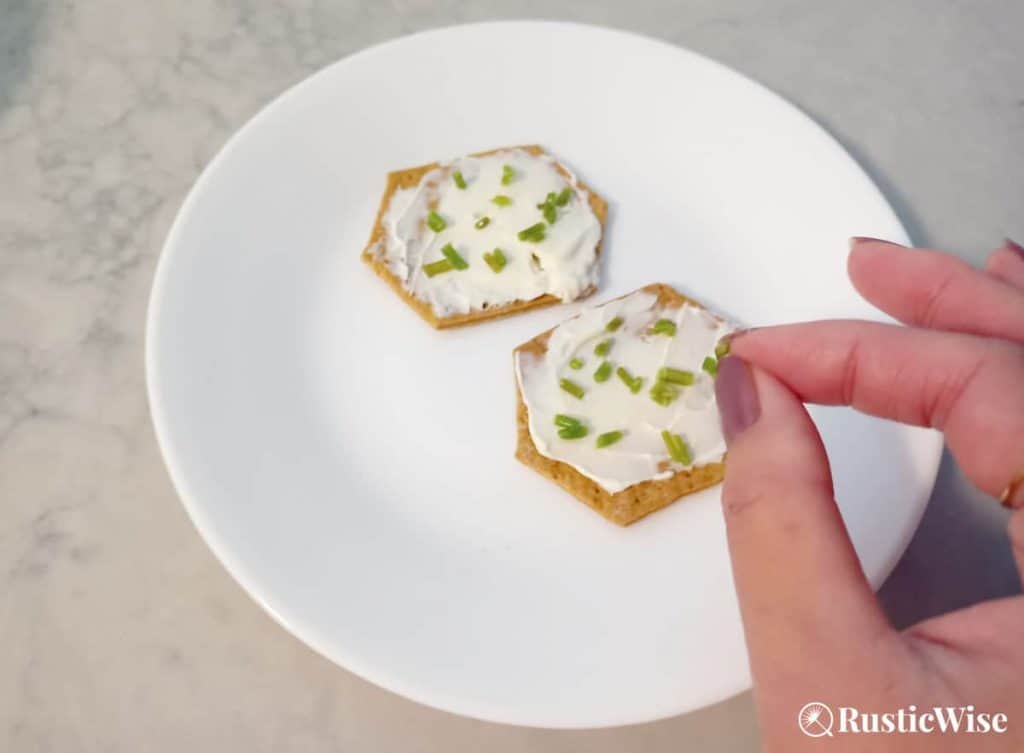
Credit: RusticWise
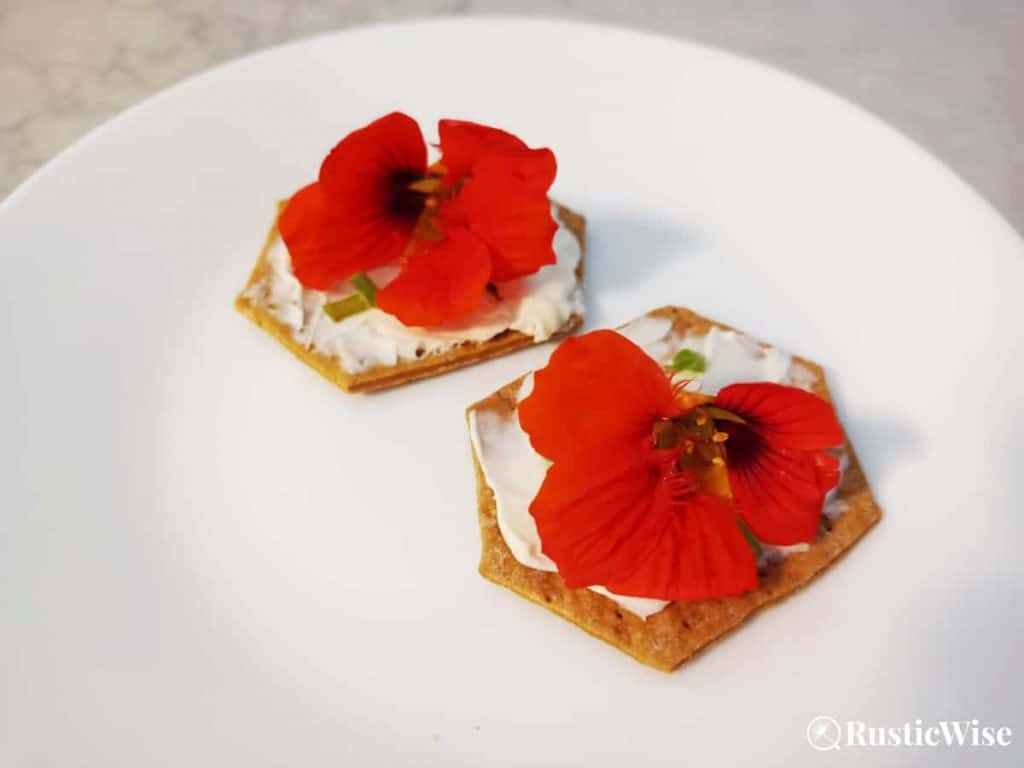
Credit: RusticWise
You’ll need:
- Sturdy crackers (any type of sturdy, savory cracker works)
- Cream cheese
- Diced nasturtium stems
- Clean nasturtium flowers
- Spread cream cheese on crackers.
- Sprinkle diced stems onto each cracker.
- Top off with a nasturtium bloom on top of each cracker.
Fancy pickled nasturtium seeds
The following recipe is gleaned from the handy tome, The Encyclopedia of Country Living by Carla Emery.⁴
You can either make pickled refrigerator capers which must be stored in the fridge. OR, you can choose to process the jars using a hot water bath (boiling water) which would let you keep the jars in your pantry.
If you’re new to water bath canning, check out our Comprehensive Guide to Canning here.
Washing seeds: To prepare seeds, collect seeds, and wash in cool running water to remove any dirt and debris.
Note: Use 1/2 pint jars (8 ounces). If canning, process in a boiling water bath for 15 minutes.
Fancy pickled nasturtium seed capers
Yield: 2 jars
Ingredients:
- 2 cups clean nasturtium seeds
- 1 cup white vinegar
- 2 sliced cloves of garlic
- 1/2 teaspoon whole dill
- 1/2 teaspoon mustard seed
- 1 teaspoon pickling salt
- 1 teaspoon whole peppercorns
- Place clean seeds in jars (about 1 cup per jar).
- In a saucepan, combine white vinegar, cloves of garlic, dill, mustard seed, salt, and peppercorns.
- Bring to a boil.
- Strain and pour liquid over nasturtium seeds.
- Place lids on jars. If making refrigerator capers, store in the fridge and let the flavors to steep for at least 2 weeks before enjoying. OR, process for 15 minutes in a water bath canner.
Related questions
What are some good nasturtium companion plants?
Nasturtium does well when grown alongside cabbages, radishes, and fruit trees. Nasturtium is actually a beneficial plant (or sacrificial plant) to have in your garden, as it keeps harmful insects away from other crops.
For example, caterpillars will munch on nasturtium leaves instead of on cabbage. Snails and slugs will feast on the leaves too.
Will nasturtium attract pollinators to my garden?
Yes, this edible plant attracts beneficial insects such as pollinators. You’ll notice bees and butterflies coming to feed on the flower nectar in the springtime.
👉 If you like this post, see our Timeless Guide To Foraging for Wild Food. 🌿
Would you like more timeless tips via email?
Fun tips to help you live an independent, self-sustaining lifestyle. Opt-out at any time.


References
- Plants For a Future (PFAF), Tropaeolum majus – L., https://pfaf.org/user/plant.aspx?LatinName=Tropaeolum+majus. Accessed September 2022.
- Britannica, Nasturtium, plant, Tropaeolum genus, https://www.britannica.com/plant/nasturtium-Tropaeolum-genus. Accessed September 2022.
- Institute of Culinary Education, How to Use Nasturtium Leaves, Flowers and Shoots, https://ice.edu/blog/nasturtium-seeds-nasturtium-leaves. Accessed September 2022.
- Emery, Carla (2012). The Encyclopedia of Country Living, 40th Anniversary Edition. Sasquatch Books. ISBN-13: 978-1-57061-840-6.

Author: Theresa Tesolin
Theresa is co-founder of RusticWise. She helps people unleash their inner DIY spirit by encouraging them to get dirty and make or grow something from scratch.

